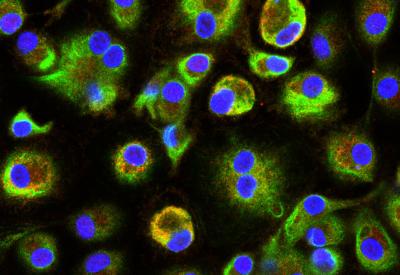Activation of 2 genes linked to development of atherosclerosis

Immunofluorescence staining for PARP9 (red) and PARP14 (green) with nuclei shown in blue. Credit: Masanori Aikawa, Brigham and Women's Hospital
Though the mechanisms that activate macrophages, a type of digestive white blood cell that targets foreign cells, remain incompletely understood, previous research shows that macrophages play an important role in the development of atherosclerosis and its thrombotic complications.
Masanori Aikawa, MD, PhD, director of the Center for Interdisciplinary Cardiovascular Sciences (CICS) at the Brigham, his research fellow Hiroshi Iwata, MD, PhD, and colleagues studied atherosclerosis on the protein-level to determine which molecules were most involved in the regulation of macrophages.
Once Aikawa and his colleagues narrowed down their search to these two proteins, they silenced each gene in cultured macrophages and found that tamping down PARP14 increased macrophage activation while tamping down PARP9 had the opposite effect.
Aikawa founded CICS and hopes that this hypothesis-generating method can be used to streamline the lengthy process of drug development. Aikawa and CICS are using a more systematic approach which hinges on network analysis; this analysis predicts which pathways are most likely to control their studied effect so that they can prioritize these pathways. Ideally, this process would take a fraction of the time in comparison to searching through each individual pathway unaware of their likelihood of affecting their studied effect.
Aikawa and his colleagues plan to augment these findings to develop targeted therapeutics for atherosclerosis and other diseases.
“Macrophage activation plays a role in not only vascular disorders but also various inflammatory and autoimmune diseases,” said Aikawa. “These results could provide important information about the mechanisms of these diseases and help to develop much needed new therapeutics.”
###
Paper cited: Iwata H et al. “PARP9 and PARP14 cross-regulate macrophage activation via STAT1 ADP-ribosylation.” Nature Communications DOI: 10.1038/NCOMMS12849
Media Contact
All latest news from the category: Life Sciences and Chemistry
Articles and reports from the Life Sciences and chemistry area deal with applied and basic research into modern biology, chemistry and human medicine.
Valuable information can be found on a range of life sciences fields including bacteriology, biochemistry, bionics, bioinformatics, biophysics, biotechnology, genetics, geobotany, human biology, marine biology, microbiology, molecular biology, cellular biology, zoology, bioinorganic chemistry, microchemistry and environmental chemistry.
Newest articles

Sea slugs inspire highly stretchable biomedical sensor
USC Viterbi School of Engineering researcher Hangbo Zhao presents findings on highly stretchable and customizable microneedles for application in fields including neuroscience, tissue engineering, and wearable bioelectronics. The revolution in…

Twisting and binding matter waves with photons in a cavity
Precisely measuring the energy states of individual atoms has been a historical challenge for physicists due to atomic recoil. When an atom interacts with a photon, the atom “recoils” in…

Nanotubes, nanoparticles, and antibodies detect tiny amounts of fentanyl
New sensor is six orders of magnitude more sensitive than the next best thing. A research team at Pitt led by Alexander Star, a chemistry professor in the Kenneth P. Dietrich…





















